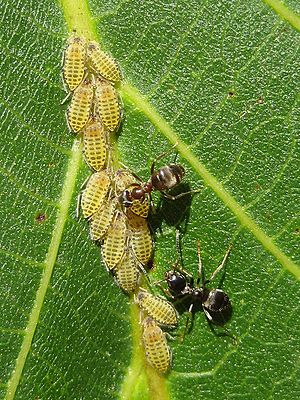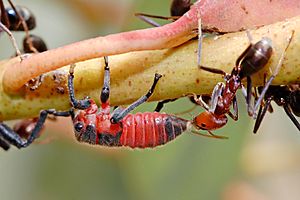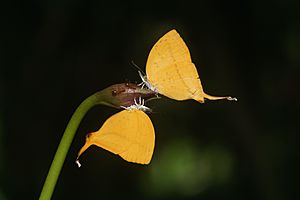Myrmecophily facts for kids

Myrmecophily (say it: mur-mə-KOF-ə-lee) means "love of ants." It describes special friendships between ants and other living things. These can be plants, other insects, or even fungi. Most of the time, both the ants and their friends help each other. This is called a mutualistic relationship. Sometimes, only one benefits, or one even harms the other.
About 10,000 different kinds of ants live around the world. They are very common, especially in warm places. Ants are often the main predators (hunters) of other small creatures. Because of this, ants are very important in nature. Scientists think that these special friendships have helped ants become so successful. They get a steady supply of food, which helps them compete with other predators. Many of these friendships are "facultative." This means both species can live without the other. But some are "obligate," meaning one or both species need the friendship to survive.
As ant nests get bigger, they tend to have more kinds of ant-loving creatures. This is because larger ant colonies have more different jobs and spaces inside. This allows more types of myrmecophiles to live there.
Contents
What is a Myrmecophile?
A "myrmecophile" is any living thing that lives closely with ants.
Myrmecophiles can have many different jobs in an ant colony. Many of them help clean the nest. They eat things like dead ants, dead ant babies, or fungi growing in the nest. Some myrmecophiles eat the ants' stored food. A few even eat ant eggs or young ants. But others help the ants by giving them food. Most of these friendships are helpful but not necessary for survival. However, many myrmecophile relationships are "obligate." This means one or both partners need the relationship to live.
Myrmecophiles are very well known among certain butterflies. These are from the family Lycaenidae. Many caterpillars of these butterflies make a sweet liquid called nectar. They have special organs for this. They also "talk" to the ants using sounds and vibrations. Scientists believe that having ants around helps protect the caterpillars. The ants keep away other insects that might try to harm them.
Many kinds of beetles are also myrmecophiles. These include some ladybirds and many others. Among beetles, the rove beetles are the most diverse group living with ants. Other insects like aphids and treehoppers also have these friendships. Even some hoverfly species live with ants.
Ant nests are safe and organized places. They are protected by the ant colony. This makes them attractive to many myrmecophiles. These ant guests can have a good, neutral, or bad effect on the colony. If a guest harms the colony too much, the ants might discover them. This usually means there are only a few myrmecophiles in a nest. Some spiders can even pretend to be ants. This is called ant mimicry. They might also use special chemicals to trick ants. They do this to get into nests, often to steal food or even eat the ants. A tiny mite called Aribates javensis always lives in ant nests. Ants take care of these mites. In return, the mites eat trash and bacteria in the nest.
Other groups of myrmecophiles include:
- Orthoptera, like the cricket Myrmecophilus acervorum.
- Diptera, such as the fly Clitellaria obtusa.
- Blattodea, like the Attaphila cockroaches.
- Molluscs, such as the snail Allopeas myrmekophilos.
A man named Horace Donisthorpe wrote one of the first big books about myrmecophiles in Britain. This was in 1927.
Ant-Plant Friendships
Ants and plants have special friendships all over the world. Hundreds of plant species are "myrmecophytes," or ant plants. These include plants in the pea, spurge, and orchid families. Usually, ant plants give ants a place to live and food. In return, the ants "tend" to the plants. This means they protect them, help spread their seeds, reduce competition from other plants, keep them clean, and even give them nutrients.
Three common ways ant plants help ants are:
- Extrafloral nectaries: These are nectar-producing spots outside the plant's flowers. They attract and feed ants.
- Domatia: These are hollow spaces in the plant. They can be in stems, leaf stalks, thorns, or curled leaves. Ants use them as homes.
- Beltian bodies: These are tiny, energy-rich food packets on the tips of leaves.
Extrafloral nectaries are found on many plants. They are not for pollination. Their main job is to attract and keep ants nearby. Plants can even control how much nectar they release. This helps them get more ant activity when they need protection most. The food from these nectaries and Beltian bodies can be a major food source for ants. Sometimes, it's all an ant colony needs.
In exchange for homes and food, ants protect plants from animals that eat plants (herbivores). A famous example is the bullhorn acacia tree and its Pseudomyrmex ants in Central America. Scientists like Daniel Janzen studied this. He showed that ants greatly reduce how much plants are eaten. The acacia trees give the ants homes, Beltian bodies, and nectar. The ants can live only on these foods. These ants are very aggressive. They will bite and spray acid on large animals to protect their plant home.
Ants also help plants in other ways. They keep leaf surfaces clean and fight off plant diseases. Ants often trim away other plants, like epiphytes and vines, from their host plant. This helps the ant plant get more space, light, and water. Scientists have also found that nutrients can flow both ways. For example, a tree might give ants food. But the ants bring nutrients from outside back to the tree. This helps the tree grow. All these services make myrmecophily very helpful for a plant's survival.
Ant-Arthropod Friendships
Many arthropods (insects, spiders, mites) depend on ants. They live inside ant nests. Mites are especially good at being myrmecophiles. They are small enough to get into nests easily. They also don't get kicked out by the ants. Studies show that mites have many more myrmecophilous species than other groups.
Ant-Insect Friendships
Ants "tend" (care for) many insect species. The most well-known are certain butterfly caterpillars and sap-sucking insects called hemipterans. About 41% of all ant groups include species that work with insects. In these friendships, ants provide a service. In return, they get nutrients, often in the form of honeydew. Honeydew is a sugary liquid that many plant-eating insects excrete. This relationship is often called "trophobiosis." This word combines the idea of feeding with living together.
Insects can also adapt to deal with aggressive ants. This can lead to helpful or even parasitic relationships. Some beetles have special behaviors, body shapes, and chemicals to trick ants. They use these to prey on aphids that ants are tending.
Hemiptera
Some of the most studied myrmecophile friendships are between ants and hemipterans. These include especially aphids. There are about 4,000 known aphid species. They are the most common myrmecophiles in northern temperate areas. Aphids feed on plant sap. As they feed, they release honeydew droplets. The ants drink this honeydew. Then they take it back to their nest to share with other ants.
Aphid honeydew is mostly sugar (90-95%). It also has vitamins, minerals, and amino acids. This honeydew can be a huge food source for ants. Some aphids can even produce more honeydew per hour than their own body weight! For some ants, aphids are their only food. Ants might also eat some aphids if there are too many. This gives them extra protein. It also makes sure the honeydew keeps flowing at a good rate. Even with some ants eating them, aphid colonies grow larger when ants tend them. Ants protect their large "herds" of aphids from predators and parasites. Aphids that live with ants often have fewer ways to defend themselves. They rely on the ants for protection.
Ants also form friendships with other honeydew-producing hemipterans. These include scale insects, mealybugs, and treehoppers. Most of these are flexible friendships. But some are "obligate," meaning the insects can only live inside ant nests. Besides protection, ants might offer other services. Some ants bring young hemipterans into their nests and raise them with their own young. Ants may also help hemipterans move around. Queen ants have been seen carrying aphids when they start a new colony. Worker ants often carry aphids to new plants. This ensures a fresh food source and protection for the "herd."
Lycaenid Butterflies
Myrmecophily in lycaenid caterpillars is different from aphids. Caterpillars eat plant tissues, not sap. So, they don't constantly excrete honeydew. These caterpillars have special organs that release chemicals to feed and calm the ants. These chemicals are a mix of sugar and amino acids. This mix is more attractive to ants than either one alone. Some caterpillars even produce sounds. These sounds make the ants more active. This makes the ants better at defending the caterpillars.
Ants protect lycaenid caterpillars from predators and parasitic wasps. These wasps lay their eggs inside other insect larvae. For example, one study found that caterpillars tended by ants were much less likely to be infected by parasites. However, this friendship costs the butterfly energy. Caterpillars tended by ants grow into smaller adults. This is because they use energy to make chemicals for the ants.
Ants are important to these butterflies at all stages of their lives. Many female butterflies lay their eggs on plants where ants are present. They might use ant chemicals to find these spots. This ensures their young will be cared for by ants. While ant attendance is well known in lycaenid butterflies, many other moths and butterflies also associate with ants.
Why Myrmecophily is Important
Friendships between species are found everywhere in nature. They play a huge role in all ecosystems. Since ants are one of the most common life forms on Earth, myrmecophily is very important. It affects how many different species there are. It also shapes how communities of living things are organized.
How Friendships Evolve
Scientists are very interested in how and why species evolve together. For many myrmecophilous organisms, their ant friendships have helped them succeed and become diverse. Studies show that myrmecophily has developed many times independently in different groups. This means it's a very successful strategy.
Scientists also study the costs and benefits of these friendships. These can change a lot depending on the local environment. For example, the amount of food available or the number of predators can affect the relationship. Sometimes, these changes can make a friendship shift. It might go from being helpful to being neutral, or even harmful. In almost all friendships, one partner benefits more than the other. This can lead to "cheating." One partner might try to get benefits without giving anything back. For example, some lycaenid caterpillars are taken into ant nests. But instead of helping, they eat the ant babies! Much is still unknown about how these friendships stay stable over time.
Living Together
Friendships also help different species live side-by-side. Myrmecophily helps species coexist that might otherwise fight or compete. For many myrmecophiles, living with ants is a way to avoid being eaten by ants. Lycaenid caterpillars, for instance, are soft and nutritious. They would be easy prey for ants. But they have evolved complex ways to calm ants and get their protection. Why do ants cooperate instead of eating them? Scientists think it's because cooperation gives ants food that's hard to find. Or it ensures they have a long-term food supply.
Community Structure
Myrmecophilous interactions influence where species live, how many there are, and how they interact. They affect competition between species. They also control the numbers of arthropods, fungi, and plants. In tropical forests, ant friendships can control entire communities of arthropods in the treetops. Myrmecophily has also been key to the success of ants themselves. Ants are so abundant in many places that they couldn't survive on prey alone. Myrmecophily helps support these large ant populations. Ants are also considered "ecosystem engineers." They create safe places and improve habitats for many species.
Myrmecophily as a Model
Myrmecophilous interactions are a great way to study big questions in ecology and evolution. These questions include how species evolve together, how plants defend themselves, and how food webs are structured. Many of these relationships are easy to study and experiment with. This makes them ideal for learning about how common and important mutualisms are in nature.
See also
 In Spanish: Mirmecófilo para niños
In Spanish: Mirmecófilo para niños
- Myrmecochory
- Myrmecophyte
- Myrmecotrophy
- Myrmecomorphy (ant mimicry)





